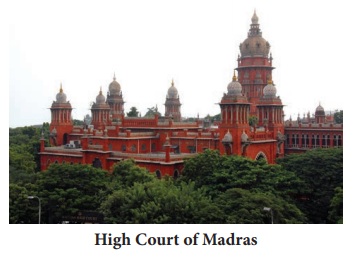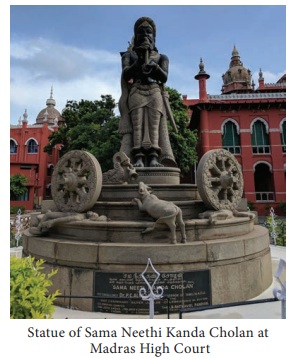Jurisdiction and Powers of High Court - Judiciary of State (High Courts) | 10th Social Science : Civics : Chapter 3 : State Government of India
Chapter: 10th Social Science : Civics : Chapter 3 : State Government of India
Judiciary of State (High Courts)
Judiciary of State
High Courts
The
institution of high court originated in India in 1862 when the high courts were
set up at Calcutta, Bombay and Madras. In the course of time, each province in
British India came to have its own high court. After 1950, a high court
existing in a province became the high court for the corresponding state. The
High Courts are the highest courts at State level.

The
Constitution of India provides for a high court for each state, but the Seventh
Amendment Act of 1956 authorised the Parliament to establish a common high
court for two or more states or for two or more states and a union territory.
For
example, the States of Punjab and Haryana and the Union Territory of Chandigarh
have a common High Court situated at Chandigarh. The High Court of Guwahati is
common for four northeastern States of Assam, Nagaland, Mizoram and Arunachal
Pradesh. The High Court of Guwahati has its benches in Itanagar,
The High Court of Madras is the one
of the three High Courts in India established in the three Presidency Towns of
Bombay, Calcutta and Madras by letters patent granted by Queen Victoria,
bearingdate 26 June 1862. The High Court building is the second largest
judicial complex in the world after London.
Kohima
and Aizwal. Delhi, though not a State, has its own separate High Court. Every
High Court has a Chief Justice and a number of judges. The number of judges
varies from State to State. The number of judges of each High Court is
determined by the President. At present there are 25 High Courts for 28 States
(including new Andhra Pradesh High Court established in 1st January 2019 at
principal seat in Amravati) and nine Union Territories.
Jurisdiction and Powers of High Court
Original Jurisdiction
In their
judicial capacity, the High Courts of the Presidency towns (Bombay, Calcutta
and Madras) have both original and appellate jurisdictions, while other High
Courts have mostly appellate jurisdiction.
Only in
matters of admiralty, probate, matrimonial and contempt of Court, they have
original jurisdiction. The Presidency High Courts have original jurisdiction in
which the amount involved is more than ₹2000 and in criminal cases which are
committed to them by the Presidency Magistrates.
Appellate Jurisdiction
As Courts
of appeal, all High Courts entertain appeals in civil and criminal cases from
their subordinate Courts as well as on their own.
They
have, however, no jurisdiction over tribunals established under the laws
relating to the Armed Forces of the Country.
Writ Jurisdiction
Under
Article 226 of the constitution, the High Courts are given powers of issuing
writs not only for the enforcement of the Fundamental Rights, but also for
other purposes. In exercise of this power, a Court may issue the same type of
writs, orders or directions which the Supreme Court is empowered to issue under
Article 32.
The
jurisdiction to issue writs under this Article is larger in the case of High
Courts, for which the Supreme Court can issue them only where a Fundamental
Right has been infringed, a High Court can issue them not only in suchcases,
but also where an ordinary legal right has been infringed. It has the power to
issue the five kinds of Writs like Habeas Corpus, Mandamus, Prohibition, Quo
Warranto, Certiorari.
Supervisory Jurisdiction
High
court has the power of superintendence over all courts and tribunals
functioning in its territorial jurisdiction (except military courts or tribunals)
Thus, it may
• Call for
returns from them;
• Make an
issue, general rules and prescribe forms for regulating the practice and
proceedings of them.
• Prescribe
forms in which books, entries and accounts are to be kept by them; and
• Settle
the fees payable to the sheriff, clerks, officers and legal practitioners of
them.
Court of Record
All the
decisions and decrees issued by the High Court are printed and are kept as a
record for future references by the Court as well as by the lawyers, is such a
need arises. Thus, it also acts as a Court of Record.

Related Topics